Terry Odell's Blog, page 269
October 21, 2011
Friday Field Trip - More Fall Colors
Jason wanted to shoot some fall colors, but he was looking for early morning light shots. He and Hubster took off before sunrise so he'd be able to capture what he was looking for. Also--although barely a week had passed since I took my pictures, the cold snap before Jason's trip meant some major changes in the scenery. And, because he's a photographer and I merely take pictures, his are definitely works of art. Enjoy! (click to enlarge)

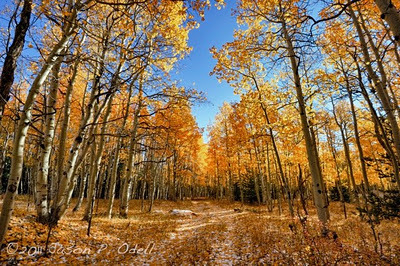



And, because boys will be boys, he had to shoot some old mining crap equipment.
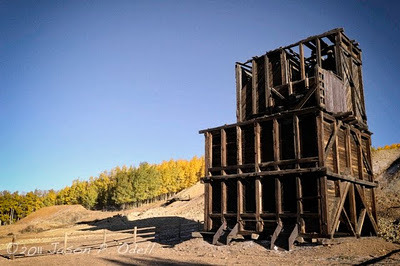
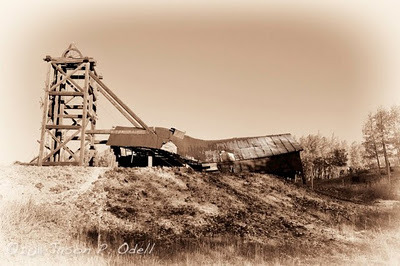
For more of Jason's work, visit his website to see his galleries.
(Be sure to check the Deals & Steals tab for my giveaways)
Like this post? Please share by clicking one of the links below.





And, because boys will be boys, he had to shoot some old mining crap equipment.


For more of Jason's work, visit his website to see his galleries.
(Be sure to check the Deals & Steals tab for my giveaways)
Like this post? Please share by clicking one of the links below.
Published on October 21, 2011 04:00
October 20, 2011
Metaphorically Speaking – or Not
What I'm reading: Seal Team Six, by Howard E. Wasdin
First – a new contest in my Deals & Steals tab. I've got too many books, and would love to find new homes for them.
Next: I'm over at Beth Groundwater's blog today, responding to her interview questions, one of which requires I reveal something I've never posted anywhere else. [image error]
Note: today's post is based on the kind of reading and writing I do--often referred to as "commercial fiction" to distinguish it from "literary fiction." If you're reading or writing literary fiction, feel free to ignore my observations.
I struggle with descriptions. I don't like metaphors. Or similes. At least I don't like having to come up with good ones. And they have to be good, or they're a waste of time.
Things to watch for:
1. Use the vocabulary of your character, not yours.
Here's a snip from DANGER IN DEER RIDGE. Grinch has brought Elizabeth to his private place in the woods.
"I used to sit here and look at the sky. I knew someday I'd be a pilot."
"Just the sky?" She swept her arm in a broad circle. "What about the way the water sparkles in the sunlight. And how the aspens dance when the breeze passes through their branches. It's like the trees are wearing sequined evening gowns."
He smiled. "I admit, I never conjured up that evening gown image. But yeah, this whole place is … serene, I guess."
Now, Grinch was brought up in the country, became a pilot, and works for a covert ops team. If he'd been the one describing the scene using Elizabeth's words, would it have worked? I don't think so. (Obviously, because I wrote it with Elizabeth speaking them!)
2. Don't let them slow the pace.
Every time you compare something to something else, you're giving the reader two images to deal with. They have to stop and conjure up the new image, and no matter how good it is, you risk pulling them away from the read for the moment it takes to visualize your comparison.
3. Don't use other people to describe yours.
If your reader has no experience with whomever you're comparing your character to, you can pull them even farther away. Saying, "her lips reminded him of (insert movie star here) won't work at all if your reader hasn't seen or heard of XXX. And it can date your work to boot.
4. Don't overload your reader.
While a good metaphor can evoke an emotional reaction as well as a visual one, they need to be meted out sparingly. I recall the chapter I submitted to my crit partners after taking a workshop from Margie Lawson about how to create these emotion-packed metaphors. They both came back with "overkill!" in their feedback.
How about this one? Both my crit partners thought I'd gone to far, despite the fact that I labored long and hard to find a logical comparison for Ashley, who's a pastry chef. (And now you'll see the reason for today's blog image)
Her mind whirled like a mixer whipping egg whites into meringue.
How would you fix it? (Or do you think it works?)
Tomorrow, we're going on another field trip. But as I write this post, I'm not exactly sure where. Would love some of you to share your pictures. (And doing so enters you in my giveaway!)
Like this post? Please share by clicking one of the links below.
First – a new contest in my Deals & Steals tab. I've got too many books, and would love to find new homes for them.
Next: I'm over at Beth Groundwater's blog today, responding to her interview questions, one of which requires I reveal something I've never posted anywhere else. [image error]
Note: today's post is based on the kind of reading and writing I do--often referred to as "commercial fiction" to distinguish it from "literary fiction." If you're reading or writing literary fiction, feel free to ignore my observations.
I struggle with descriptions. I don't like metaphors. Or similes. At least I don't like having to come up with good ones. And they have to be good, or they're a waste of time.
Things to watch for:
1. Use the vocabulary of your character, not yours.
Here's a snip from DANGER IN DEER RIDGE. Grinch has brought Elizabeth to his private place in the woods.
"I used to sit here and look at the sky. I knew someday I'd be a pilot."
"Just the sky?" She swept her arm in a broad circle. "What about the way the water sparkles in the sunlight. And how the aspens dance when the breeze passes through their branches. It's like the trees are wearing sequined evening gowns."
He smiled. "I admit, I never conjured up that evening gown image. But yeah, this whole place is … serene, I guess."
Now, Grinch was brought up in the country, became a pilot, and works for a covert ops team. If he'd been the one describing the scene using Elizabeth's words, would it have worked? I don't think so. (Obviously, because I wrote it with Elizabeth speaking them!)
2. Don't let them slow the pace.
Every time you compare something to something else, you're giving the reader two images to deal with. They have to stop and conjure up the new image, and no matter how good it is, you risk pulling them away from the read for the moment it takes to visualize your comparison.
3. Don't use other people to describe yours.
If your reader has no experience with whomever you're comparing your character to, you can pull them even farther away. Saying, "her lips reminded him of (insert movie star here) won't work at all if your reader hasn't seen or heard of XXX. And it can date your work to boot.
4. Don't overload your reader.
While a good metaphor can evoke an emotional reaction as well as a visual one, they need to be meted out sparingly. I recall the chapter I submitted to my crit partners after taking a workshop from Margie Lawson about how to create these emotion-packed metaphors. They both came back with "overkill!" in their feedback.
How about this one? Both my crit partners thought I'd gone to far, despite the fact that I labored long and hard to find a logical comparison for Ashley, who's a pastry chef. (And now you'll see the reason for today's blog image)
Her mind whirled like a mixer whipping egg whites into meringue.
How would you fix it? (Or do you think it works?)
Tomorrow, we're going on another field trip. But as I write this post, I'm not exactly sure where. Would love some of you to share your pictures. (And doing so enters you in my giveaway!)
Like this post? Please share by clicking one of the links below.
Published on October 20, 2011 04:00
October 19, 2011
What's Cooking Wednesday - Pastel de Elote
Thanks to Mike Befeler for his post yesterday. Life certainly is a balancing act.
Once a month a group of neighbors (the ROMEOs, which stands for "Retired Old Men Eating Out") has a pot-luck supper where the spouses of said Old Men are invited to attend. I wonder if it's because some (not all, to be fair) of these men like that the wives often do the cooking.
At any rate, there was a chili theme last month, and there were the usual side dishes, but one stood out for me. I asked the woman, Sally Parda, if she'd mind sharing, and she gladly agreed. She pointed out that she adapted a cookbook recipe, and I've included her modifications. I made it according to the directions, and it was just as yummy as the one she brought. And it's one of those, "toss everything into a bowl, mix, and bake recipes, so it goes together quickly.
Pastel de Elote (Mexican Corn Pie)
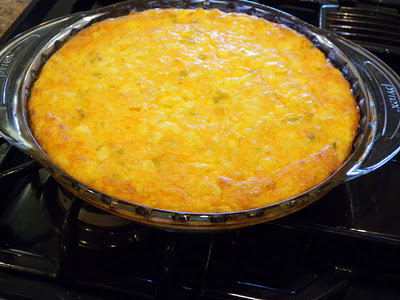
Ingredients
3 Large Eggs
1 8 3/4 -oz can cream style corn
1 10-oz package frozen corn, thawed and drained. (I just dumped it onto several layers of paper towels to thaw. If you're pressed for time, run it under hot water, then drain.)
1/2 cup butter, melted
1/2 cup yellow corn meal
1 cup sour cream (8oz) or 8oz Greek yogurt (my market sells the Greek yogurt in 6 oz containers, so I made up the difference with the sour cream)
4 oz shredded Monterey Jack Cheese
4 oz shredded sharp Cheddar cheese
Our market sold a shredded "Mexican" mix of jack and cheddar, so I used that.
1 4-oz can chopped mild green chiles
1/2 tsp salt
Directions
Grease a 10" pie plate or iron skillet* with shortening, or spray with a non-stick spray.
In a large bowl, beat eggs. Add remaining ingredients and stir until thoroughly mixed. Pour into greased pan.
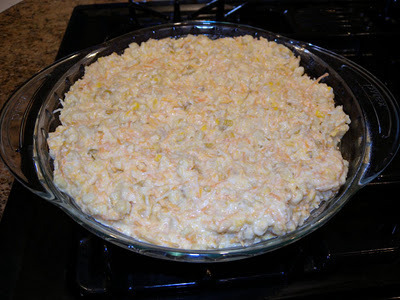
Bake uncovered at 350 degrees for 1 hour. It's done when the custard has set. Insert a knife about 1/3 out from the center. If it's clean, it's done.

*Note: If using the iron skillet, place in oven while it is preheating...makes the outside crust crispier.
Sally's modifications: Instead of the corn meal, she used a box of Krusteaz Honey Corn Bread mix leaving out the salt. She also did not have the frozen corn to add to the mix, so she left it out.
Like this post? Please share by clicking one of the links below.
Once a month a group of neighbors (the ROMEOs, which stands for "Retired Old Men Eating Out") has a pot-luck supper where the spouses of said Old Men are invited to attend. I wonder if it's because some (not all, to be fair) of these men like that the wives often do the cooking.
At any rate, there was a chili theme last month, and there were the usual side dishes, but one stood out for me. I asked the woman, Sally Parda, if she'd mind sharing, and she gladly agreed. She pointed out that she adapted a cookbook recipe, and I've included her modifications. I made it according to the directions, and it was just as yummy as the one she brought. And it's one of those, "toss everything into a bowl, mix, and bake recipes, so it goes together quickly.
Pastel de Elote (Mexican Corn Pie)

Ingredients
3 Large Eggs
1 8 3/4 -oz can cream style corn
1 10-oz package frozen corn, thawed and drained. (I just dumped it onto several layers of paper towels to thaw. If you're pressed for time, run it under hot water, then drain.)
1/2 cup butter, melted
1/2 cup yellow corn meal
1 cup sour cream (8oz) or 8oz Greek yogurt (my market sells the Greek yogurt in 6 oz containers, so I made up the difference with the sour cream)
4 oz shredded Monterey Jack Cheese
4 oz shredded sharp Cheddar cheese
Our market sold a shredded "Mexican" mix of jack and cheddar, so I used that.
1 4-oz can chopped mild green chiles
1/2 tsp salt
Directions
Grease a 10" pie plate or iron skillet* with shortening, or spray with a non-stick spray.
In a large bowl, beat eggs. Add remaining ingredients and stir until thoroughly mixed. Pour into greased pan.

Bake uncovered at 350 degrees for 1 hour. It's done when the custard has set. Insert a knife about 1/3 out from the center. If it's clean, it's done.

*Note: If using the iron skillet, place in oven while it is preheating...makes the outside crust crispier.
Sally's modifications: Instead of the corn meal, she used a box of Krusteaz Honey Corn Bread mix leaving out the salt. She also did not have the frozen corn to add to the mix, so she left it out.
Like this post? Please share by clicking one of the links below.
Published on October 19, 2011 04:00
October 18, 2011
Art of Balancing Writing and Job
Today, join me in welcoming mystery writer Mike Befeler to Terry's place. Mike writes the Paul Jacobson Geezer-lit Mystery series. After a 39-year career in the computer industry he retired to write full time. In this blog post, he describes a technique to balance the demands of writing while holding down a full time day job.
(And while Mike holds down the fort at Terry's Place, I'm over at The Blood-Red Pencil talking about the pitfalls of "ing" words.)
For a number of years, like many people, I wrote while working full time. Unlike many writers who have been at it since they were eight years old, I entered this writing world at the age of fifty-six when I made the decision to pursue fiction writing as a vocation I could retire into rather than just retire away from my day job. The benefit of undertaking writing at this age—more life experience than the young whippersnappers and more outside of work time with my kids grown so no soccer games, swim meets, concerts and plays to attend.
When I began writing novel length material, I came across a technique in the book The Artist's Way by Julia Cameron. Julia describes Morning Pages as a way of getting the creative juices flowing by writing three handwritten pages first thing in the morning. These can be anything—a shopping list, a journal, anything you choose to write.
I took this concept and adapted it to my particular needs. I'm a morning person, so I enjoy writing first thing in the day. When I was working full time, I knew I would be wiped out at the end of the work day and not be able to concentrate on being creative. So my solution was to adapt the Morning Pages concept as follows: First thing every morning I reviewed where I had left off the day before in my novel. Then wrote three handwritten pages to continue the story. I went off to work, and when I returned in the evening, I entered these pages into my computer, performing an editing pass along the way. This typically produced two typed pages.
And the arithmetic—if I kept this up for 150 days, I'd have a rough draft for a 300 page novel. Although I wasn't able to do this every day, I was consistent enough that I produced the rough drafts for my three published novels using this technique. I don't claim that this will work for everyone, but it is one way to write while working full time.
I have always tried to exercise every day, and many times this consisted of taking walks. While working full time, I would often take a walk at lunchtime when my meeting schedule and travel allowed. I found this to be an excellent time to brainstorm whatever manuscript I happened to be writing. I would carry a notepad and pen with me, and when an idea occurred, I'd jot it down.
Finally, once I completed my rough draft, I went through numerous editing/revision cycles. These I typically did on weekends. I had editing passes for story flow, consistency, grammar, repetitive words. On the final pass I read it out loud.
Now that I've retired from my thirty-nine year career in the computer industry to write full time, I've modified this process again. I now write directly into the computer in the morning, take my mid-day walk to brainstorm and do editing, email, social networking and promotional activities in the afternoon.
Each writer has a process that works best for him or her. This has been mine, and until I change again, I'm sticking with it.
Mike Befeler's novels include three books in the Paul Jacobson Geezer-lit Mystery series: Retirement Homes Are Murder, Living with Your Kids Is Murder and Senior Moments Are Murder. Living with Your Kids Is Murder was a finalist for the Lefty Award for the best humorous mystery of 2009. You can learn more about Mike at his website , his blog , or on Facebook .
Like this post? Please share by clicking one of the links below.
(And while Mike holds down the fort at Terry's Place, I'm over at The Blood-Red Pencil talking about the pitfalls of "ing" words.)
For a number of years, like many people, I wrote while working full time. Unlike many writers who have been at it since they were eight years old, I entered this writing world at the age of fifty-six when I made the decision to pursue fiction writing as a vocation I could retire into rather than just retire away from my day job. The benefit of undertaking writing at this age—more life experience than the young whippersnappers and more outside of work time with my kids grown so no soccer games, swim meets, concerts and plays to attend.
When I began writing novel length material, I came across a technique in the book The Artist's Way by Julia Cameron. Julia describes Morning Pages as a way of getting the creative juices flowing by writing three handwritten pages first thing in the morning. These can be anything—a shopping list, a journal, anything you choose to write.
I took this concept and adapted it to my particular needs. I'm a morning person, so I enjoy writing first thing in the day. When I was working full time, I knew I would be wiped out at the end of the work day and not be able to concentrate on being creative. So my solution was to adapt the Morning Pages concept as follows: First thing every morning I reviewed where I had left off the day before in my novel. Then wrote three handwritten pages to continue the story. I went off to work, and when I returned in the evening, I entered these pages into my computer, performing an editing pass along the way. This typically produced two typed pages.
And the arithmetic—if I kept this up for 150 days, I'd have a rough draft for a 300 page novel. Although I wasn't able to do this every day, I was consistent enough that I produced the rough drafts for my three published novels using this technique. I don't claim that this will work for everyone, but it is one way to write while working full time.
I have always tried to exercise every day, and many times this consisted of taking walks. While working full time, I would often take a walk at lunchtime when my meeting schedule and travel allowed. I found this to be an excellent time to brainstorm whatever manuscript I happened to be writing. I would carry a notepad and pen with me, and when an idea occurred, I'd jot it down.
Finally, once I completed my rough draft, I went through numerous editing/revision cycles. These I typically did on weekends. I had editing passes for story flow, consistency, grammar, repetitive words. On the final pass I read it out loud.
Now that I've retired from my thirty-nine year career in the computer industry to write full time, I've modified this process again. I now write directly into the computer in the morning, take my mid-day walk to brainstorm and do editing, email, social networking and promotional activities in the afternoon.
Each writer has a process that works best for him or her. This has been mine, and until I change again, I'm sticking with it.
Mike Befeler's novels include three books in the Paul Jacobson Geezer-lit Mystery series: Retirement Homes Are Murder, Living with Your Kids Is Murder and Senior Moments Are Murder. Living with Your Kids Is Murder was a finalist for the Lefty Award for the best humorous mystery of 2009. You can learn more about Mike at his website , his blog , or on Facebook .
Like this post? Please share by clicking one of the links below.
Published on October 18, 2011 05:00
October 17, 2011
Planning a POV Workshop
Today's picture goes with last week's post about discovery drafts vs editing as you go. It' a t-shirt I saw in a catalog and couldn't resist. Maybe I'll wear it to my next RWA chapter meeting.
[image error] Because I'm going to be doing a workshop on Point of View at the Emerald City conference, I thought I'd share some of the things I plan to cover as I prepare my speaker notes. If you have any POV issues you think I should include in the workshop, let me know. I'll lead off with the various types of POV, but didn't think I needed to include that here. Since I write in deep POV, that's going to be the focus of my workshop.
Point of view (POV) is the vantage point from which we show a section of the story to the reader -- and it's one of the hardest things to deal with when we write.
Usually, we only tell the story through the eyes of one character -- or at least one character at a time. When we switch back and forth, the reader is jerked from one person's head to the other, and it's hard to develop empathy for either character.
Using POV
If we've chosen to use our heroine's POV, then the reader will see what the heroine sees, hear what the heroine hears, and know most of what the heroine's thinking.
The reader won't know what anyone else is thinking, or what's happening behind the heroine's back, or what's said after she leaves the room. If the heroine doesn't see it, hear it, smell it or taste it, then it can't happen for the reader -- not in that scene, at least.
So how do you show the other character's state of mind (like the hero)? We'll know his state of mind by what he says, what he does, how he acts, and what the heroine thinks about it.
Let's try an example. Sally's the heroine, and she has just confronted Joe, the hero, about a lie she thinks he's told her. Sally's the POV character. How can we make sure our readers connect with Sally and know what's going on with Joe?
• Include her feelings as she works herself up to express herself. (Should she say it? Her head feels like it's going to burst. Maybe it would be better to stay silent because he'll only lie to her again.)
• Describe what she sees. (Joe's jaw sets. The corner of his mouth twitches. He looks away instead of straight at her. His knuckles go white.)
• Include what she thinks. ("He's looking away rather than at me, so that must mean he's admitting he was lying, or he'd look me in the eye.")
In Sally's POV, we never include what Joe's thinking -- we don't know if he's feeling guilty for lying, or upset because he has been unjustly accused -- and we don't need to know. Knowing what everybody's thinking will throw all the suspense right out the window. We know what Sally thinks, but we don't know whether she's right. And that makes readers want to keep turning the pages!
Tomorrow, I'll be over at The Blood-Red Pencil for my monthly column. Mike Befeler, author of the Geezer Lit mystery series will be my guest. He's talking about balancing work and writing -- be sure to come back.
Like this post? Please share by clicking one of the links below.
[image error] Because I'm going to be doing a workshop on Point of View at the Emerald City conference, I thought I'd share some of the things I plan to cover as I prepare my speaker notes. If you have any POV issues you think I should include in the workshop, let me know. I'll lead off with the various types of POV, but didn't think I needed to include that here. Since I write in deep POV, that's going to be the focus of my workshop.
Point of view (POV) is the vantage point from which we show a section of the story to the reader -- and it's one of the hardest things to deal with when we write.
Usually, we only tell the story through the eyes of one character -- or at least one character at a time. When we switch back and forth, the reader is jerked from one person's head to the other, and it's hard to develop empathy for either character.
Using POV
If we've chosen to use our heroine's POV, then the reader will see what the heroine sees, hear what the heroine hears, and know most of what the heroine's thinking.
The reader won't know what anyone else is thinking, or what's happening behind the heroine's back, or what's said after she leaves the room. If the heroine doesn't see it, hear it, smell it or taste it, then it can't happen for the reader -- not in that scene, at least.
So how do you show the other character's state of mind (like the hero)? We'll know his state of mind by what he says, what he does, how he acts, and what the heroine thinks about it.
Let's try an example. Sally's the heroine, and she has just confronted Joe, the hero, about a lie she thinks he's told her. Sally's the POV character. How can we make sure our readers connect with Sally and know what's going on with Joe?
• Include her feelings as she works herself up to express herself. (Should she say it? Her head feels like it's going to burst. Maybe it would be better to stay silent because he'll only lie to her again.)
• Describe what she sees. (Joe's jaw sets. The corner of his mouth twitches. He looks away instead of straight at her. His knuckles go white.)
• Include what she thinks. ("He's looking away rather than at me, so that must mean he's admitting he was lying, or he'd look me in the eye.")
In Sally's POV, we never include what Joe's thinking -- we don't know if he's feeling guilty for lying, or upset because he has been unjustly accused -- and we don't need to know. Knowing what everybody's thinking will throw all the suspense right out the window. We know what Sally thinks, but we don't know whether she's right. And that makes readers want to keep turning the pages!
Tomorrow, I'll be over at The Blood-Red Pencil for my monthly column. Mike Befeler, author of the Geezer Lit mystery series will be my guest. He's talking about balancing work and writing -- be sure to come back.
Like this post? Please share by clicking one of the links below.
Published on October 17, 2011 04:00
October 15, 2011
Last Day to Save!
Today is the LAST day to save 50% on FINDING SARAH and HIDDEN FIRE at Smashwords.
Click the Deals & Steals tab above for links and codes.
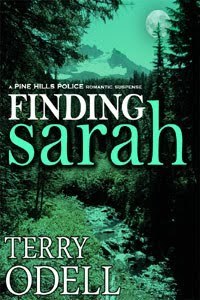
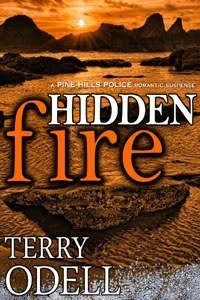
Also, only 5 more Google Connect followers until I'll give away some books. New or gently read. I need to make room for more.
Click the Deals & Steals tab above for links and codes.


Also, only 5 more Google Connect followers until I'll give away some books. New or gently read. I need to make room for more.
Published on October 15, 2011 06:37
October 14, 2011
Friday Field Trip - Colorado Vistas
First: tomorrow is the last day to use the 50% off coupon at Smashwords for Finding Sarah & Hidden Fire. Click the Deals and Steals tab for links and codes. Also. as of the time of scheduling this post, I need only 5 more Google followers before there's a giveaway.
A few weeks ago, I mentioned that we'd gone up to the American Eagle Overlook, and there was lots of old mining crap equipment. There were also some vistas, which I promised to share with you. We also hiked another nearby trail, which also had lots of old mining crap equipment and more vistas. And a critter. Today it's just vistas (and the critter).
First - there's an active gold mine below the overlook. (And when you drive up there, the guard makes it very clear that you are not welcome anyplace other than the road to the overlook.) Personally, I prefer the views away from the mining operation, although the guys liked watching the big trucks.

[image error]
[image error]



[image error]
[image error]
And the critter.
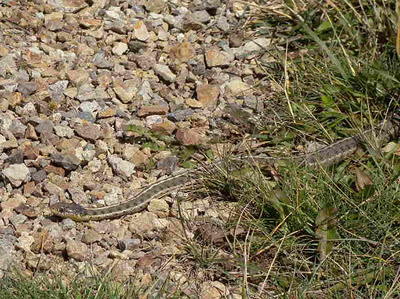
Like this post? Please share by clicking one of the links below.
A few weeks ago, I mentioned that we'd gone up to the American Eagle Overlook, and there was lots of old mining crap equipment. There were also some vistas, which I promised to share with you. We also hiked another nearby trail, which also had lots of old mining crap equipment and more vistas. And a critter. Today it's just vistas (and the critter).
First - there's an active gold mine below the overlook. (And when you drive up there, the guard makes it very clear that you are not welcome anyplace other than the road to the overlook.) Personally, I prefer the views away from the mining operation, although the guys liked watching the big trucks.

[image error]
[image error]



[image error]
[image error]
And the critter.

Like this post? Please share by clicking one of the links below.
Published on October 14, 2011 04:00
October 13, 2011
Mystery or Suspense..or Romance?
What I'm reading: The Sentry, by Robert Crais
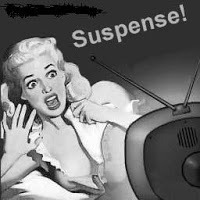 I've noticed a fair number of recent blog posts offering tips about writing compelling suspense. They were all good, except I don't really like suspense. I'm a mystery fan, first and foremost.
I've noticed a fair number of recent blog posts offering tips about writing compelling suspense. They were all good, except I don't really like suspense. I'm a mystery fan, first and foremost.
Often we see the two genres combined—it's not unusual to see "mystery/suspense" as a category. But they're not the same. According to the dictionary, suspense is a state of uncertainty, enjoyable tension, or anxiety. A mystery is something you cannot explain, or don't know anything about. It's easy to see how they overlap. But there are distinct differences.
Let's take a look at both:
In a mystery, the reader follows a step behind the detective/protagonist as he or she solves the crime. The reader doesn't know anything until the protagonist does. Normally, the crime has already happened, and the detective has to figure out who did it. Mysteries are puzzles.
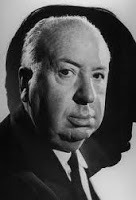 In a suspense, the reader is a step ahead of the detective/protagonist. A suspense is usually about preventing a crime before it happens, or catching the killer before he kills again, or stopping the villain from blowing up New York, or any number of threatening possibilities.
In a suspense, the reader is a step ahead of the detective/protagonist. A suspense is usually about preventing a crime before it happens, or catching the killer before he kills again, or stopping the villain from blowing up New York, or any number of threatening possibilities.
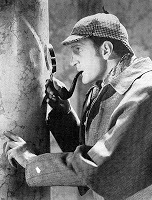 Often the major difference in writing a mystery as opposed to a suspense will boil down to POV. If there's a villain's POV, then the reader knows what's happened. Suspense. Think Alfred Hitchcock.
Often the major difference in writing a mystery as opposed to a suspense will boil down to POV. If there's a villain's POV, then the reader knows what's happened. Suspense. Think Alfred Hitchcock.
If there's only the detective's POV (and I'm being simplistic, because often there are multiple POV characters in a mystery, but they're not the villain), then the reader doesn't know what happened. Mystery. Think Sherlock Holmes.
And then, there's the other side of the bookstore, the romance aisles. In it is the broad category the publishing industry calls "romantic suspense" which comprises all the sub-genres of mystery, from cozy to thriller. There's the added hero/heroine story arc, with its requisite Happily Ever After. However, by tacking that 'suspense' term onto the genre, readers might be expecting an actual suspense, not a mystery, and be disappointed.
There can be elements of both, however.
FINDING SARAH starts off as a mystery. Sarah's shop has been robbed and she calls the police. The detective, Randy, tries to solve it. However, later in the book, Randy and Sarah are separated, and Sarah is in danger. Now, the reader will see things through Sarah's eyes that Randy doesn't know, and things through Randy's eyes that Sarah doesn't know. This creates suspense, even though the book wasn't intended as a strictly suspense novel.
In HIDDEN FIRE, the same two characters are part of a more classic mystery. There's been a murder, and Randy must figure out who did it. The reader never sees the killer, so it wouldn't be classified as a suspense.
In DANGER IN DEER RIDGE, because the villain was obvious, I included his POV, and that added elements of suspense to the story. But, in my mind, it's still more of a mystery. If I'd been responsible for labeling romance books that include mystery sub-genres, I'd probably have included a "mystery romance" moniker. But nobody asked me (they never do), so we've got romantic suspense novels that might not have any suspense in them. That's why I like to think of my own books as "Mysteries With Relationships."
Like this post? Please share by clicking one of the links below.
 I've noticed a fair number of recent blog posts offering tips about writing compelling suspense. They were all good, except I don't really like suspense. I'm a mystery fan, first and foremost.
I've noticed a fair number of recent blog posts offering tips about writing compelling suspense. They were all good, except I don't really like suspense. I'm a mystery fan, first and foremost.Often we see the two genres combined—it's not unusual to see "mystery/suspense" as a category. But they're not the same. According to the dictionary, suspense is a state of uncertainty, enjoyable tension, or anxiety. A mystery is something you cannot explain, or don't know anything about. It's easy to see how they overlap. But there are distinct differences.
Let's take a look at both:
In a mystery, the reader follows a step behind the detective/protagonist as he or she solves the crime. The reader doesn't know anything until the protagonist does. Normally, the crime has already happened, and the detective has to figure out who did it. Mysteries are puzzles.
 In a suspense, the reader is a step ahead of the detective/protagonist. A suspense is usually about preventing a crime before it happens, or catching the killer before he kills again, or stopping the villain from blowing up New York, or any number of threatening possibilities.
In a suspense, the reader is a step ahead of the detective/protagonist. A suspense is usually about preventing a crime before it happens, or catching the killer before he kills again, or stopping the villain from blowing up New York, or any number of threatening possibilities. Often the major difference in writing a mystery as opposed to a suspense will boil down to POV. If there's a villain's POV, then the reader knows what's happened. Suspense. Think Alfred Hitchcock.
Often the major difference in writing a mystery as opposed to a suspense will boil down to POV. If there's a villain's POV, then the reader knows what's happened. Suspense. Think Alfred Hitchcock.If there's only the detective's POV (and I'm being simplistic, because often there are multiple POV characters in a mystery, but they're not the villain), then the reader doesn't know what happened. Mystery. Think Sherlock Holmes.
And then, there's the other side of the bookstore, the romance aisles. In it is the broad category the publishing industry calls "romantic suspense" which comprises all the sub-genres of mystery, from cozy to thriller. There's the added hero/heroine story arc, with its requisite Happily Ever After. However, by tacking that 'suspense' term onto the genre, readers might be expecting an actual suspense, not a mystery, and be disappointed.
There can be elements of both, however.
FINDING SARAH starts off as a mystery. Sarah's shop has been robbed and she calls the police. The detective, Randy, tries to solve it. However, later in the book, Randy and Sarah are separated, and Sarah is in danger. Now, the reader will see things through Sarah's eyes that Randy doesn't know, and things through Randy's eyes that Sarah doesn't know. This creates suspense, even though the book wasn't intended as a strictly suspense novel.
In HIDDEN FIRE, the same two characters are part of a more classic mystery. There's been a murder, and Randy must figure out who did it. The reader never sees the killer, so it wouldn't be classified as a suspense.
In DANGER IN DEER RIDGE, because the villain was obvious, I included his POV, and that added elements of suspense to the story. But, in my mind, it's still more of a mystery. If I'd been responsible for labeling romance books that include mystery sub-genres, I'd probably have included a "mystery romance" moniker. But nobody asked me (they never do), so we've got romantic suspense novels that might not have any suspense in them. That's why I like to think of my own books as "Mysteries With Relationships."
Like this post? Please share by clicking one of the links below.
Published on October 13, 2011 04:00
October 12, 2011
What's Cooking Wednesday - Noodle Kugel
What I'm reading: Texas! Chase, by Sandra Brown; Crunch Time, by Diane Mott Davidson (NOOK); Silk is for Seduction, by Loretta Chase (bike)
Thanks to Judy Alter for yesterday's post. Fame and Fortune are what we make of them, aren't they?
And, I'm guest blogger at Katherine Grey's blog today. Please stop by.
And now, onward with this week's recipe:
Noodle Kugel with Chocolate Chips and Dried Fruit
There were a lot of recipes for noodle kugel circulating through the social networking sites in conjunction with Yom Kippur. The holiday includes a 24 hour fast, and dairy dishes are commonly part of the fast-breaking meals. I've been making a noodle kugel for years, but I decided to try a new variation this time.
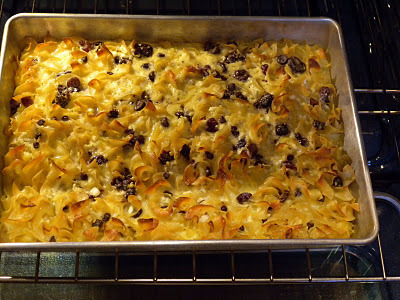
12 oz. pkg. medium or wide noodles, cooked and drained.
4 tsp. butter, melted
4 eggs
½ c. sugar
1 pint cottage cheese
1 ½ c. sour cream
¼ c. milk
1 tsp. vanilla
Approximately 1 ¼ c of a combination of chocolate chips and dried fruits.*
(Vary amounts of each according to taste)
*Raisins are traditional, but I had this bag of mixed dried fruits, so I used those. And those antioxidant claims counteract all the eggs and butter and creamy stuff, right?
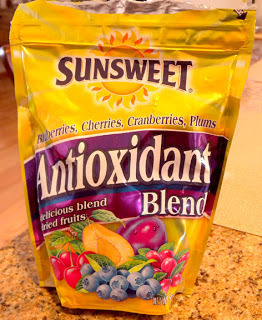
Instructions:
Butter or spray a 9 x 13 inch pan with non-stick spray
Beat together eggs and sugar. Ad cottage cheese, sour cream, melted butter, milk and vanilla and mix well.
Fold in cooked noodles and the chips and dried fruit.
Pour mixture into prepared pan.
Bake for 40 minutes to 1 hour, until mixture is just set.
(Note: you probably don't want your noodles quite this brown & crispy--but then, you probably don't live at 9100 feet, so the cooking temperature and times given should be more accurate where you live. I happen to like the crunch, but that's just me.)
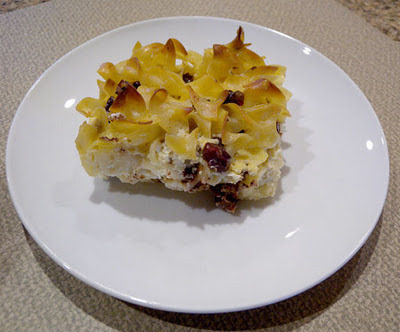
(Another note: Not half bad served with whipped cream or ice cream)
Like this post? Please share by clicking one of the links below.
Thanks to Judy Alter for yesterday's post. Fame and Fortune are what we make of them, aren't they?
And, I'm guest blogger at Katherine Grey's blog today. Please stop by.
And now, onward with this week's recipe:
Noodle Kugel with Chocolate Chips and Dried Fruit
There were a lot of recipes for noodle kugel circulating through the social networking sites in conjunction with Yom Kippur. The holiday includes a 24 hour fast, and dairy dishes are commonly part of the fast-breaking meals. I've been making a noodle kugel for years, but I decided to try a new variation this time.

12 oz. pkg. medium or wide noodles, cooked and drained.
4 tsp. butter, melted
4 eggs
½ c. sugar
1 pint cottage cheese
1 ½ c. sour cream
¼ c. milk
1 tsp. vanilla
Approximately 1 ¼ c of a combination of chocolate chips and dried fruits.*
(Vary amounts of each according to taste)
*Raisins are traditional, but I had this bag of mixed dried fruits, so I used those. And those antioxidant claims counteract all the eggs and butter and creamy stuff, right?

Instructions:
Butter or spray a 9 x 13 inch pan with non-stick spray
Beat together eggs and sugar. Ad cottage cheese, sour cream, melted butter, milk and vanilla and mix well.
Fold in cooked noodles and the chips and dried fruit.
Pour mixture into prepared pan.
Bake for 40 minutes to 1 hour, until mixture is just set.
(Note: you probably don't want your noodles quite this brown & crispy--but then, you probably don't live at 9100 feet, so the cooking temperature and times given should be more accurate where you live. I happen to like the crunch, but that's just me.)

(Another note: Not half bad served with whipped cream or ice cream)
Like this post? Please share by clicking one of the links below.
Published on October 12, 2011 04:00
October 11, 2011
Do You Dream of Fame and Fortune
Today, my guest is author Judy Alter. Judy is the author of fiction and nonfiction for adults and young-adults. Having spent much of her career writing about women in the American West, she has turned her attention to mystery. Today, she considers what constitutes success for a writer.
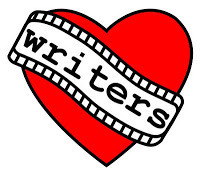 When do you consider yourself an author? And how do you define success as an author? The late Dorothy Johnson (A Man Called Horse, The Hanging Tree, The Man Who Shot Liberty Valance—you have to be old to remember those) used to say you were a writer until you published a book and then you became an author. I know for years, even after I'd published books, I'd look over my shoulder when someone asked "You're an author?" I was sure they were talking to someone behind me.
When do you consider yourself an author? And how do you define success as an author? The late Dorothy Johnson (A Man Called Horse, The Hanging Tree, The Man Who Shot Liberty Valance—you have to be old to remember those) used to say you were a writer until you published a book and then you became an author. I know for years, even after I'd published books, I'd look over my shoulder when someone asked "You're an author?" I was sure they were talking to someone behind me.
And how do you define success as an author? For most of us that first book means success—you're a published author. But as we grow and continue to write, our goals move ahead just enough to keep us always striving. There's that first major award, the breakthrough book, always a new step to be taken. I read that Blackbird Fly, which I really enjoyed, was Lise McClendon's first venture into suspense (she did very well!), and Rosemary Harris recently posted that she's writing her first novel with an omniscient point of view, after having written several from first person view. Both were challenges.
When I fretted, early in the first decade of this century, that my writing was stalled, a straightspoken friend asked, "Did you ever consider you've had as much success as you were meant to have?" No, I'd never considered that and didn't intend to. I thought my success pretty moderate in spite of a lot of titles in print and several awards hanging on my wall. I wasn't rich, and I wasn't famous—as I tell school kids all the time. But is that really the goal?
My next goal became to write a publishable mystery. This was a big challenge for me because I'd been writing mostly biographical fiction—the story is laid out for you. One of my sons once said, "Mom writes historical fiction because she's so poor at plotting"—thank you, Jamie! In a mystery, you control the plot—or you listen to your characters when they tell you what's going to happen (some authors debate that but most believe in listening to your character). One of the best pieces of advice I ever got came from the prolific mystery author Susan Wittig Albert—she advised me to join Sisters in Crime and then the Agent Quest and Guppies lists. Over four years or so, I've gotten a great education from these groups and come to realize that the world of mysteries is far different from the world of westerns which I'd earlier inhabited.
Now my mystery has launched but I have new goals: I want Skeleton in a Dead Space to be the first in a series and, having visited Scotland recently, I'd like to do a contemporary mystery with historical roots back to the battle of Culloden—and involving my ancestors from Clan MacBean. That, though, would be an enormous challenge—sweeping history, maybe time travel. I don't know what direction it would take.
Now retired and taking life much easier, I find another change in my goals. I'm not quite as ambitious, determined, driven, whatever you want to say. I want to be at my computer, but I am training a three-month-old puppy, taking care of a five-year-old after school, feeding my family and friends, and maintaining a lunch and dinner social life. I write two blogs and spend some time twice a day on Facebook, less on Twitter. I don't feel the compulsion to make every minute count toward my goal. But, yes, I still consider myself an author—maybe a mom and grandmom first.
We all dream of fame and fortune, but it will elude most of us. What are your realistic goals?
Find Judy at www.judyalter.com, or read her blogs at http://www.judy's-stew.blogspot.com and http://potluckwithjudy.blogspot.com . Skeleton in a Dead Space is available from Amazon, Smashwords or Turquoise Morning Press .
Like this post? Please share by clicking one of the links below.
 When do you consider yourself an author? And how do you define success as an author? The late Dorothy Johnson (A Man Called Horse, The Hanging Tree, The Man Who Shot Liberty Valance—you have to be old to remember those) used to say you were a writer until you published a book and then you became an author. I know for years, even after I'd published books, I'd look over my shoulder when someone asked "You're an author?" I was sure they were talking to someone behind me.
When do you consider yourself an author? And how do you define success as an author? The late Dorothy Johnson (A Man Called Horse, The Hanging Tree, The Man Who Shot Liberty Valance—you have to be old to remember those) used to say you were a writer until you published a book and then you became an author. I know for years, even after I'd published books, I'd look over my shoulder when someone asked "You're an author?" I was sure they were talking to someone behind me.And how do you define success as an author? For most of us that first book means success—you're a published author. But as we grow and continue to write, our goals move ahead just enough to keep us always striving. There's that first major award, the breakthrough book, always a new step to be taken. I read that Blackbird Fly, which I really enjoyed, was Lise McClendon's first venture into suspense (she did very well!), and Rosemary Harris recently posted that she's writing her first novel with an omniscient point of view, after having written several from first person view. Both were challenges.
When I fretted, early in the first decade of this century, that my writing was stalled, a straightspoken friend asked, "Did you ever consider you've had as much success as you were meant to have?" No, I'd never considered that and didn't intend to. I thought my success pretty moderate in spite of a lot of titles in print and several awards hanging on my wall. I wasn't rich, and I wasn't famous—as I tell school kids all the time. But is that really the goal?
My next goal became to write a publishable mystery. This was a big challenge for me because I'd been writing mostly biographical fiction—the story is laid out for you. One of my sons once said, "Mom writes historical fiction because she's so poor at plotting"—thank you, Jamie! In a mystery, you control the plot—or you listen to your characters when they tell you what's going to happen (some authors debate that but most believe in listening to your character). One of the best pieces of advice I ever got came from the prolific mystery author Susan Wittig Albert—she advised me to join Sisters in Crime and then the Agent Quest and Guppies lists. Over four years or so, I've gotten a great education from these groups and come to realize that the world of mysteries is far different from the world of westerns which I'd earlier inhabited.
Now my mystery has launched but I have new goals: I want Skeleton in a Dead Space to be the first in a series and, having visited Scotland recently, I'd like to do a contemporary mystery with historical roots back to the battle of Culloden—and involving my ancestors from Clan MacBean. That, though, would be an enormous challenge—sweeping history, maybe time travel. I don't know what direction it would take.
Now retired and taking life much easier, I find another change in my goals. I'm not quite as ambitious, determined, driven, whatever you want to say. I want to be at my computer, but I am training a three-month-old puppy, taking care of a five-year-old after school, feeding my family and friends, and maintaining a lunch and dinner social life. I write two blogs and spend some time twice a day on Facebook, less on Twitter. I don't feel the compulsion to make every minute count toward my goal. But, yes, I still consider myself an author—maybe a mom and grandmom first.
We all dream of fame and fortune, but it will elude most of us. What are your realistic goals?
Find Judy at www.judyalter.com, or read her blogs at http://www.judy's-stew.blogspot.com and http://potluckwithjudy.blogspot.com . Skeleton in a Dead Space is available from Amazon, Smashwords or Turquoise Morning Press .
Like this post? Please share by clicking one of the links below.
Published on October 11, 2011 05:00



